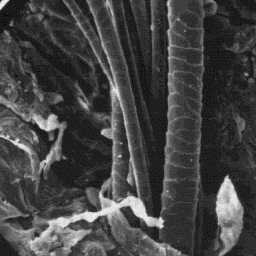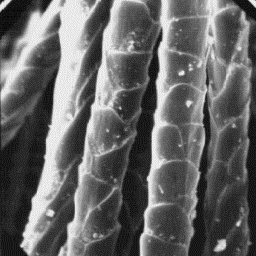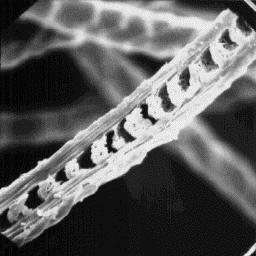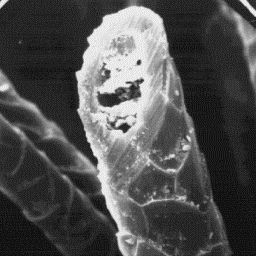 Lynx lynx
Lynx lynx
---------
English: Lynx
German: Luchs
French: Lynx
Spanish: Lince
Distribution areas
------------------
The lynx can be found in Europe, Asia
and North America. About five varieties of
lynx are known (European, Caucasian,
Altaic, Canadian and Newfoundland) and two
similar species (Lynx pardina and Lynx
rufus). The lynx is now relatively rare in
Europe. The surface structure
of the skin, 400x
Description of the fur
----------------------
The skins are from 90 to 120 cm long. The basic coloration of the coat is
yellow-grey or red-grey. The back is covered by red-brown or black-brown
spots and stripes, with diffuse margins. The under-fur is grey-white in
colour. The thickness of the undercoat is from 10 to 18 mm; the coarse guard
hairs are 35 to 45 mm long. The fine fur fibres are moderately curled; the
coarser fibres are straight.
|
|
 Lynx lynx
Lynx lynx
---------
English: Lynx
German: Luchs
French: Lynx
Spanish: Lince
Structure of the hair
---------------------
The microscopic structure of the skin
surface is furrowed. The upper parts of the
hair follicles are narrow with raised
edges. The follicles contain cluster of
from 5 to 15 fibres.
The fine fur fibres have a diameter of The cuticular structure
from 12 to 18 µm. The cross-sectional of the fine fibres, 1000x
outline is usually circular. The cuticular
scales are cornet-like with a non-regular grooved surface and straight scale
margins. The medullar column is unbroken, central symmetrical-shaped in
cross-section, and belongs to the uniserial ladder type with a foam-like
infilling substance.
|
|
 Lynx lynx
Lynx lynx
---------
English: Lynx
German: Luchs
French: Lynx
Spanish: Lince
The intermediate fur fibres are, in the
main part of the hair shaft, ellipsoidal in
cross-sectional outline. Only a small part
of the length, close to the skin surface,
is circular in cross-section. These fibres
have a diameter of from 30 to 60 µm. The
cuticular scales are rounded tile-like in
shape; the scale surface and scale margins
are smooth. The medulla is wide, unbroken Longitudinal section
and situated symmetrically in the central of a fine fur fibre, 1000x
axial part of the shaft. The overall
medullar structure belongs to the lattice-sponge-like type with a foam-like
infilling substance.
The guard hairs have a diameter of 60 to 100 µm and their cross-section is
ellipsoidal in the majority of cases. The cuticular scales are even tile-like
with a smooth scale surface and straight scale margins. In the upper part of
the hair shaft, the scale margins are often rippled.
|
|
 Lynx lynx
Lynx lynx
---------
English: Lynx
German: Luchs
French: Lynx
Spanish: Lince
The medullar column is wide, central
symmetrical-shaped in cross-section and
longitudinally unbroken. The overall struc-
ture belongs to the spongy-lattice-like type
with a foam-like infilling substance.
Transverse section
of an intermediate fibre, 1000x
|
|
 Lynx lynx
Lynx lynx
---------
English: Lynx
German: Luchs
French: Lynx
Spanish: Lince
Longitudinal section
of a guard hair, 1000x
Numerical code for lynx skin structure
--------------------------------------
Surface of the skin: 3-5-3
Fine fur fibres: 1-5-3-1-2-1-1-1-5-12.18-10.19
Intermediate fibres: 2.1-3-1-1-2-1-1-11-5-30.61-18.35
Guard hairs: 2-2-1-1.2-2-1-1-6-5-60.101-35.45
|




